Tested: 2022 Wagoneer and Grand Wagoneer Go Big for Jeep
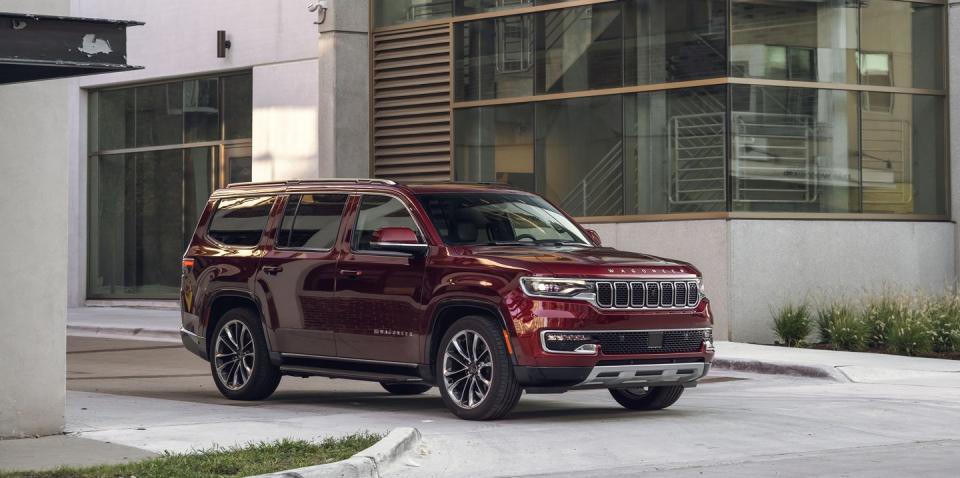
UPDATE 11/3/21: This review has been updated with test results for Wagoneer and Grand Wagoneer models.
Jeep says that the all-new 2022 Wagoneer drives like the "smallest big car." After spending time with Wagoneers and Grand Wagoneers, we'd probably drop "smallest" from the phrase. This is because at their core, these 214.7-inch-long SUVs employ the segment's proven formula: Take a full-size pickup frame, include all the big V-8 powertrain options, and build a box on top.

It's hardly that simple, of course. Unlike the Ram 1500, which the big Jeep's frame is derived from, the Wagoneer benefits from an independent rear suspension that uses a lot of aluminum, as well as a number of other chassis tweaks to improve rigidity and on-road manners. Still, these aren't lightweight trucks any more than they are small ones. Even with their composite liftgates and aluminum hoods, fenders, and doors, both trucks sit on the heavy side of the full-size SUV spectrum: The Wagoneer compressed our scales with 6244 pounds, and the more feature-filled Grand Wagoneer weighed in at 6326. All of that heft is hard to ignore when maneuvering these brutes, independent suspensions or not.
Around town, a little residual body-on-frame jiggle runs through the structure after abrupt inputs or bumps; we noticed slightly more of it in the Wagoneer than in its fancier sibling. Out on twisting roads, these big trucks roll—you should really let the inertia settle before turning their wheels in the opposite direction—and to maintain their path, their steering wheels need regular attention. That softness pays dividends on the highway, where the ride—especially the Grand Wagoneer's—is quite plush and appropriate for road trips. The throwback two-spoke steering wheel offers a vague connection to what's happening at the tires, and the overall effort is light.
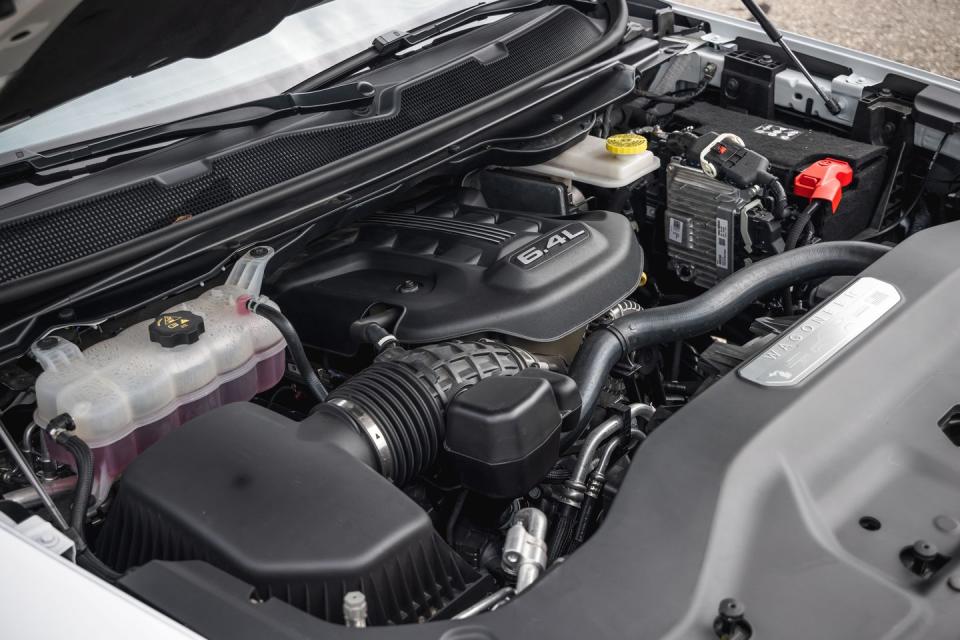
Buyers will have to parse through seven Wagoneer and Grand Wagoneer trim levels to find their best match. Wagoneers come three ways, all powered by Chrysler's Hemi 392-hp 5.7-liter V-8, which also benefits from the company's 48-volt eTorque hybrid system and an eight-speed automatic transmission. The electric assist adds up to 130 lb-ft of torque on initial throttle application and makes for one of the more seamless stop-start systems we've experienced. Equipped with the optional 3.92:1 axle ratio, the combo moves the Wagoneer's mass off the line smartly, and the smooth V-8 doesn't leave you wanting on the highway.
Grand Wagoneers come in four versions, each with a beefy 6.4-liter V-8. A GW-exclusive intake manifold and exhaust cap the fun at 471 horsepower and 455 lb-ft of torque—14 horses and 20 lb-ft short of what the engine makes in a Scat Pack Challenger. A robust torque curve gives an easy initial surge; stay in it and you'll find that the big V-8 loves to run to the top of its rev range. It sounds great, too, if a little brash in the GW's upscale environs. There's no hybrid system here, but like the 5.7-liter, cylinder deactivation and variable valve timing help make the most out of a gallon. The Grand Wagoneer is significantly livelier with its larger engine—we clocked a solid 5.4-second 60-mph time—but the lesser Wagoneer, with its electrically assisted 5.7, still moves out well and posted a respectable 6.7-second run to 60 mph. Both of those figures make these big Jeeps' acceleration wholly competitive with similar full-sizers from Cadillac, Chevy, Ford, and Lincoln.
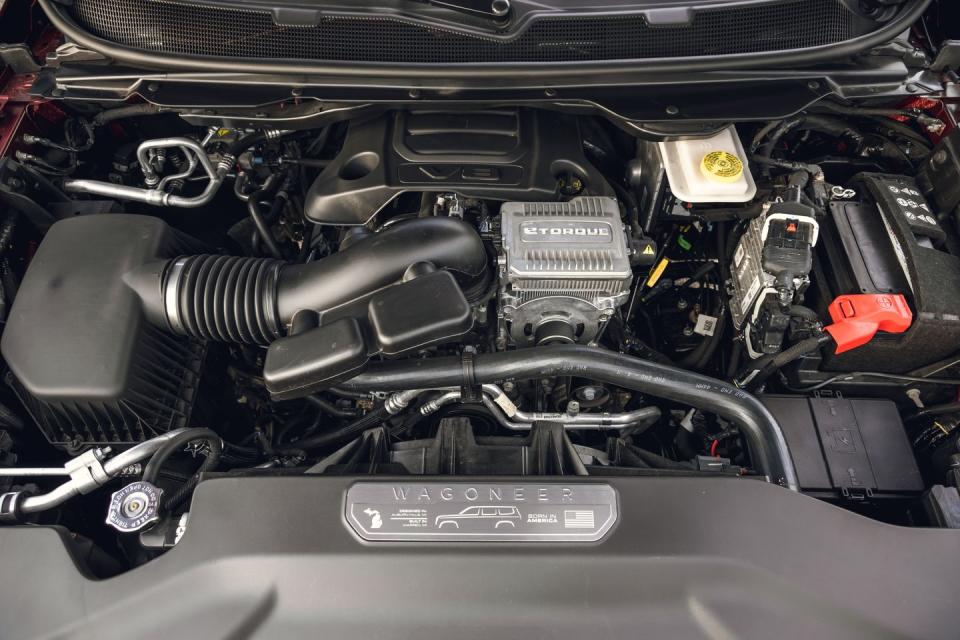
EPA fuel-economy numbers are less impressive: Four-wheel-drive Wagoneers carry labels of 15 mpg in the city and 20 on the highway; their 17-mpg-combined rating is 1 mpg short of both the Chevy Tahoe with a 5.3-liter and the Ford Expedition. Grand Wagoneers manage up to 15/13/18 mpg (combined/city/highway), which makes them similarly less efficient than the Cadillac Escalade and Lincoln Navigator. The soon-to-be-released rear-wheel-drive Wagoneer Series I will be good for an additional 1 mpg combined. Both the Wagoneer and Grand Wagoneer averaged just 13 mpg while in our care.
In a move that attempts to elevate the Wagoneer above the rest of the Jeep lineup (marketers call the Wagoneer a "premium extension of the Jeep brand"), there isn't a single Jeep badge on it, unless you count the brand's name on the startup screen for the infotainment system and as small insignias on the taillights. Yet there's no mistaking it for anything but a Jeep, and all-terrain tires are offered on the Wagoneer Series II, with 18-inch wheels, and on the Wagoneer Series III, with 20s. There are three optional drivelines: Quadra-Trac I brings full-time all-wheel drive to the Series II, the Quadra-Trac II in the Wagoneer Series III adds a two-speed transfer case and hill-descent control, and at the top of the line, any Wagoneer can be had with Quadra-Drive II, a four-wheel-drive system that nets an electronically controlled locking rear differential. That's standard on the Grand Wagoneer, optional on lesser models.
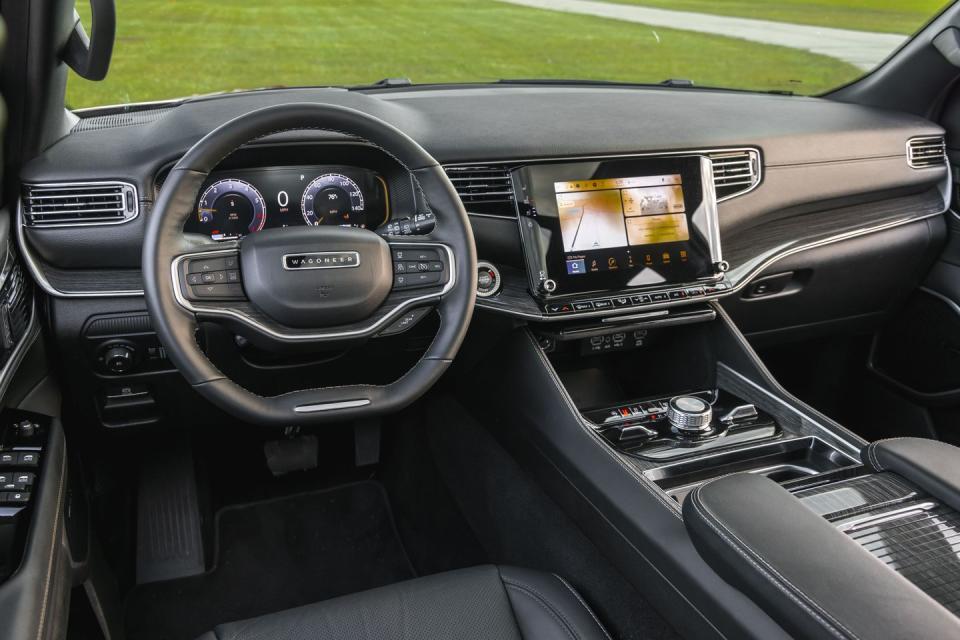
Wagoneers come standard with a load-leveling setup for the rear suspension. Four-corner Quadra-Lift air springs are optional on the Series II; Series III and Grand Wagoneer models get it standard. The system can raise the truck by 1.7 inches to give it 10.0 inches of ground clearance and up to 24 inches of water-fording capability. Additionally, it'll drop the truck 0.6 inch at speed for better aerodynamics, plus it can lower the vehicle an additional inch when parked to aid ingress and egress.
But all of that kind of misses the point: If you're shopping vehicles this big, the last thing you're thinking of is hitting fire roads. With both of our test trucks needing nearly 200 feet to stop from 70 mph and exhibiting less than 0.70 g of skidpad grip, nor will you want to search out winding country roads just for kicks. No, it's what's inside the box that matters, and Jeep designers mostly nailed it.
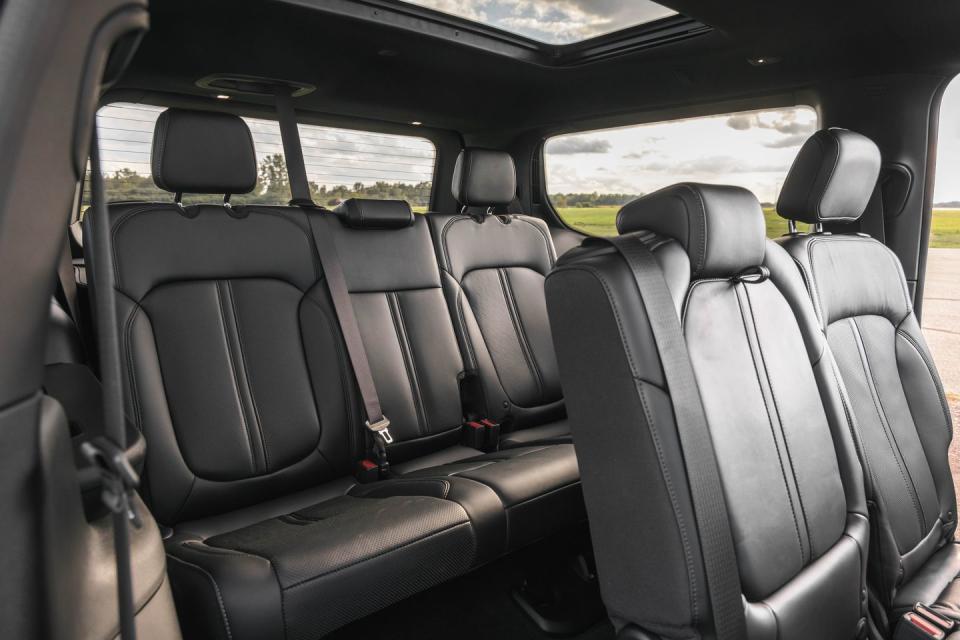
The Grand Wagoneer, in particular, offers a legitimately luxurious experience, not just for its many creature comforts, but in the interior design itself. There's a lot of wood flowing through the dash and center console. If sculpted American walnut isn't your taste, you can opt for aluminum trim instead. The seats are large and comfortable, and as you might guess, all rows inside the gigantic cabin are easily accessible. High-end details are dotted throughout, such as the knurled-aluminum gear-selection knob and the leather-wrapped start button (yes, you read that correctly). In typical Jeep fashion, the cabin is filled with reminders of what you're driving. "Grand Wagoneer" appears in large lettering on the steering wheel, the sides of the seats, and inlaid in the wood in front of the passenger's seat. By comparison, the Wagoneer's interior is a letdown with its rubberized dash material appearing to be the same as what's in a lowly Compass.
The upright, boxy exterior shape is sure to polarize, but that form gives the Wagoneer best-in-class overall passenger volume, second- and third-row legroom, third-row headroom, and cargo volume behind the third row. It's seriously roomy inside, enough so to warrant an optional camera for front-row passengers to see who threw something at them from the wayback. Interior noise levels also are appropriately hushed: We recorded a subdued 65 decibels of sound inside the Wagoneer at 70 mph and 66 in the Grand Wagoneer, although the latter's bigger V-8 did up the noise to 73 decibels at full throttle—4 decibels more than its lesser sibling.
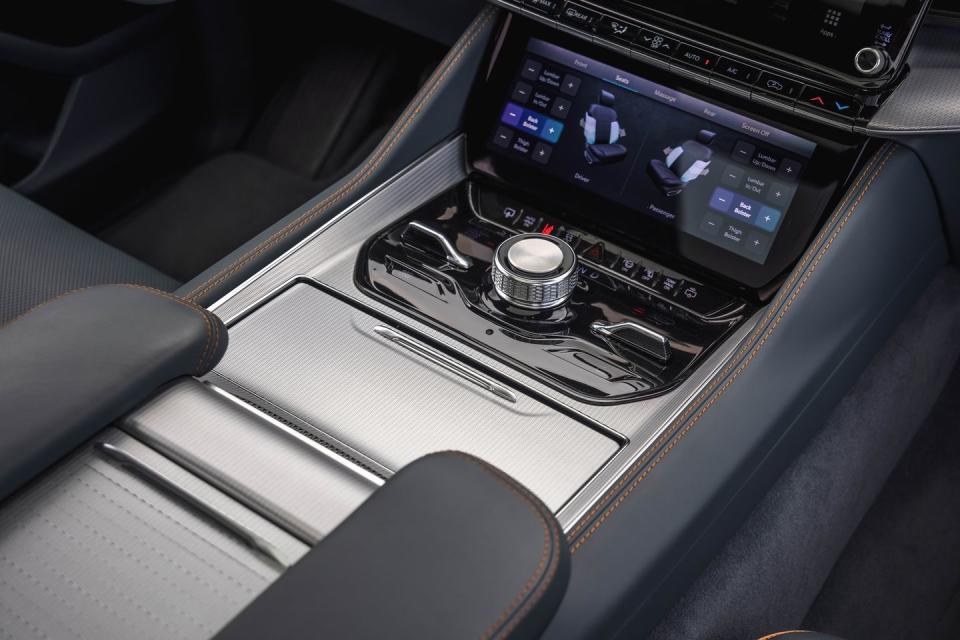
The Grand Wagoneer features four screens up front. In addition to the digital gauge cluster, there's the big center touchscreen—12.3 inches in the Grand and 10.3 in Wagoneer—and, below it, a smaller screen for secondary controls such as seat heaters and massage. An unexpected feature: The bottom screen can flip up, revealing a useful storage cubby with power outlets behind it. Front-seat passengers can have their own display flush-mounted in the dash as an $1195 option.
The sheer amount of equipment that Jeep's leviathans offer is impressive. Each trim has an extensive list of options, many unique to particular trim levels. There's an available head-up display with night vision, all the driver-assistance stuff you can imagine, Amazon Fire TV integration in the middle-row screens, and two high-end McIntosh audio systems, the grandest being a 23-speaker, 1375-watt monster with a 12-inch subwoofer. Any lingering small-big-car thoughts will be crushed by the pricing structure. Wagoneer Series II and III 4x4 models start at $73,845 and $78,845, respectively, although the Series I rear-drive version will drop the entry point to about $60K when it goes on sale in the first half of 2022. Grand Wagoneer models open at $89,845, with the top-of-the-line Series III starting at an appropriately grand $106,845.
You Might Also Like

 Yahoo Autos
Yahoo Autos 